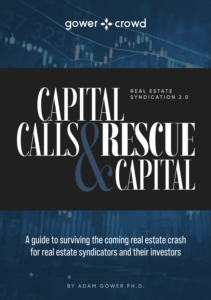The Secret Sauce of Real Estate Webinars
By Adam Gower Ph.D.
In a competitive online real estate space, you must do anything you can to differentiate yourself. Webinars are one of many tools you can use to stand out and build a more engaged, dedicated audience, but only if you do it right.
It’s easy to get webinars wrong. There are many different moving pieces in the operation and too much conflicting advice. I want to break it down to the very basics, the fundamental parts you need to pay attention in order to do webinars well.
With webinars, it all boils down to two things: sincerity and value.
Sincere Connection
Webinars vary based on the audience. No one wants to spend their time listening to robots. You don’t have to be charismatic or a professional public speaker, but you do have to be engaged in what you’re doing and sincere in your efforts to make connections with the participants.
Webinars have a unique ability to build a sense of personability between you and your audience. Because it’s a limited time thing that they have to show up for, they’re more engaged in paying attention. You need to pay back their attention by engaging with your audience and giving them something that’s worth their time.
No matter what format your webinar is – video, audio, PowerPoint presentations, etc. – make sure you’re doing it with sincerity. There’s a lot of room for error in a webinar, but as long as you’re approaching it with genuine interest in teaching or giving value to your listeners you’ll be on the right track.
Get access to our FREE weekly newsletter exclusively covering the latest updates from the real estate crowdfunding world
Providing Value
If you don’t give your audience what you tell them you’re going to, you’re wasting their time. At the heart of every webinar is the value to the participant. Where people don’t feel they’re getting value, they’ll tune out and leave the webinar before it’s even finished. If you’re not giving people something for their time and attention, what’s the point of even holding the webinar?
Value can be anything, but it needs to be catered to your intended audience and they need to know ahead of time what to expect.
Identifying Deep Pain Points
For a truly effective webinar, you need to reach the deep pain points of your audience. You can’t just address surface level problems that a million other voices are already speaking to. Go a bit deeper and find pain points that aren’t already being spoken to.
Webinars should never be just smoke and mirrors, trying to dance around the point without ever leading your audience to something of value. Your success will come from giving them the proper value for the time (and possibly money) they’re invested in joining your session. How are you making it worth their while?
Learn what their serious itch is. What’s something you can offer that will directly address a deep pain point for your audience? As a developer, you could tackle some of the specifics of investing or the development process. Tie your message into your pitch. If you’re pitching a new CRE investment, speak to a pain point that relates to CRE investments or development. This is how you’ll end up making sales from your webinar.
A webinar is essentially a sales experience. At the end of the day, it’s part of the sales funnel, not something separate. As long as you’re providing value at each step, you can bring your audience through the whole process and present calls-to-action at the right times.
Setting Expectations
No one signs up for webinars that are too vague about what’s on offer. You have to give them an idea of what to expect so they can get interested and excited. Don’t give away the goose, just use great marketing copy, videos, and whatever else to build up curiosity and intrigue.
Show that you have something worthwhile to offer participants. Give them hints and as much specific information as possible ahead of the actual event.
Webinars are specific events. Your message should be clear that this is their only chance to hear what you have to say, so they should sign up for a time slot. Unlike YouTube videos and podcasts, webinars are limited time only events, so people will miss out if they don’t sign up. Use your marketing to show them what they would be missing out on if they don’t show up for it.
***
Webinars are not the same as podcasts, videos, or other permanent content. Treat them differently and focus on coming to your audience with sincerity and value above all else. You’ll find these two elements at the core of any successful webinar and you’ll see the results as investors convert during the website, as well as following up proactively afterwards with your calls-to-action.
If you have only just started in real estate development, have completed no deals, have no email list, but know you want the freedom and wealth being a real estate developer brings, then I suggest your first step is to start evaluating deals so you can recognize a good one when you see it.
Here’s where you should start. You’ll learn everything you need to know – the different types of real estate, different development strategies, how real estate cycles influence the market, and all about due diligence.
If you want to find deals and raise money for them so you can start your real estate development business, then learning how to conduct due diligence so you can pitch your deals better to investors is a great place to start.
If you’ve already purchased one or more real estate project and are seeing more opportunities than you can finance, then now is the time to start building your investor network so you can finance all your next deals quicker.
You’ve already got some momentum; now start finding and educating prospects about what you’re doing so you can build an email list of people to pitch to when you’re ready to raise money for your next deal.
This is what we build for private clients all the time – it’s called the Investor Acquisition System and you can access the entire program right here so you can find prospects, and convert them into being deep pocketed, repeat investors in your deals.
If you are a seasoned pro with multi-cycle experience, a substantial portfolio, a decent deal pipeline, and find yourself spending too much time raising equity capital because you’re still doing it in-person, then it’s time you put technology to work for you.
The wonderful thing about doing this is that you’re not going to be doing anything different than you’re already doing and, guess what, you’ll never have to sit through investor meetings again.
Sounds crazy I know, but I lay the whole thing out for you in this white board workshop where I personally show you exactly what it takes for you to transform your equity raising into a fully automated, capital raising machine so you can find new investors while increasing commitments from your existing network.






